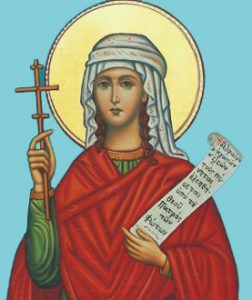October Saints
Saint Hedwig was born in Bavaria, one of the eight children born to the Count of Andechs and Duke of Croatia and Dalmatia, Berthold IV. Hedwig had her education at the monastery of Kitzengen and at the age of twelve was married to Henry I of Silesia.
The union of Henry and Hedwig brought the Duke closer relations to Germany, since his mother was German and he was educated in that country. Their reign rendered important services to civilisation in the realm; Henry I was an energetic prince who established his authority on a firm basis, and Hedwig exercised her great influence in the government of the land through her prudence, fortitude, and piety.
The couple gave their support to new monastic foundations, including, among many, the convent of the Cistercian nuns at Trebnitz in 1202. They had seven children. After her husband’s death, Hedwig gave away her fortune and took on the grey habit of the Cistercians. She cared for the sick, both personally and by founding hospitals, while supporting the poor. Privately she gave herself up to meditation on supernatural things, fasted and practised abstinence. Hedwig died in 1243.
Saint Hedwig, obtain for us true concern for the poor and underprivileged.
(Source: http://www.sthedwigbucktown.org/aboutus/parishpatron/tabid/101/default.aspx)
Saint Tabitha, the widow raised from the dead by the Apostle Peter, was a virtuous and kindly woman who belonged to the Christian community in Joppa. Being grievously ill, she suddenly died.
At the time, the Apostle Peter was preaching at Lydda, not far from Joppa. Messengers were sent to him with an urgent request for help. When the Apostle arrived at Joppa, Tabitha was already dead. On bended knee, St Peter made a fervent prayer to the Lord. Then he went to the bed and called out, ‘Tabitha, get up!’ She arose, completely healed (Acts 9:36).
St Tabitha is considered the patron saint of tailors and seamstresses, since she was known for sewing coats and other garments (Acts 9:39).
Saint Tabitha, teach us to use our talents for the good of the Church.
 Blessed Diego Luis de San Vitores
Blessed Diego Luis de San Vitores
(1627-1672)
Diego Luis de San Vitores was born in the town of Burgos, Spain. A pious boy, he told his family he wanted to join the Jesuits. Despite being devout Catholics, his parents were strongly opposed, but they gradually softened in the face of his persistence and in 1640 he entered the Jesuit novitiate near Madrid, making his vows at age 16, and being ordained a priest in 1651. After working as a teacher and preacher for some years, Diego experienced a growing restlessness to preach the Gospel to those who did not yet know Christ. His Superiors were reluctant to let him go, until he fell seriously ill three times and recovered only when he made a solemn promise to spend his life on the missions.
In May 1660, he set out for the Philippines. For six years he worked as a teacher, preacher and parish priest, but his heart was set on going to the Marianas, which he had visited en route from Spain. He pestered Spanish officials until finally, in 1666, he received the necessary permission. He arrived in Guam in July 1668, along with five other Jesuits, several lay volunteers and 32 soldiers.
At the invitation of a local chief, the mission headquarters were set up at Agana. From here Father Diego organised his religious and military troops. He himself lived the poverty of Jesus and went from village to village instructing people in the faith. His poor sight meant he had to be led by others to avoid bumping into obstacles. His only baggage in his journeys was his breviary, a Bible, the holy oils, a supply of holy cards, lamps and biscuits.
Trouble was not long coming, despite the promising start of the new mission. A Chinese castaway appeared responsible for spreading lies about the priests and their mission. In denouncing some of the ancient religious customs, the priests also caused some anger. After several outbreaks of violence interspersed with periods of uneasy peace, in April 1672 Father Diego and his catechist Pedro Calungsod were accosted by a native noble, once a convert. When the priest baptised his sick daughter against his wishes, both he and the catechist were slaughtered. He died as he had lived – with love and forgiveness in his heart and a prayer on his lips.
Blessed Diego, teach us to forgive our enemies.
(Source: Internet – various)


 Entries(RSS)
Entries(RSS)